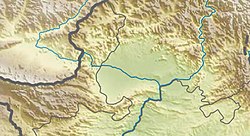 | |
| Coordinates | 34°21′58″N 70°28′08″E / 34.366041°N 70.468981°E |
|---|---|
| Type | Buddhist monastery |
| History | |
| Founded | 1st century BCE |
| Abandoned | 9th century CE |


Tapa Shotor, also Tape Shotor or Tapa-e-shotor ("Camel Hill"),[5] was a large Sarvastivadin monastery near Hadda, Afghanistan, and is now an archaeological site.[6] According to archaeologist Raymond Allchin, the site of Tapa Shotor suggests that the Greco-Buddhist art of Gandhara descended directly from the art of Hellenistic Bactria, as seen in Ai-Khanoum.[7] Alexander the Great and Herakles are represented together with the Buddha as Vajrapani in niches V2 and V3, thus according to Lucas Christopoulos, demonstrating the adoption of Buddhism by the Indo-Greeks in a context of an "Helleno-Buddhist Universalism."[8] The site of Tapa Shotor was destroyed by arson and looted in 1992.[1]
- ^ a b Cite error: The named reference
ZTSRH62was invoked but never defined (see the help page). - ^ "Tepe Shotor Tableau. Hadda, Nangarhar Province. ACKU Images System". ackuimages.photoshelter.com.
- ^ Behrendt, Kurt A. (2007). The Art of Gandhara in the Metropolitan Museum of Art. Metropolitan Museum of Art. ISBN 978-1-58839-224-4.
- ^ Boardman, George. The Greeks in Asia. pp. Greeks and their arts in India.
- ^ Vanleene, Alexandra. "The Geography of Gandhara Art" (PDF): 143.
{{cite journal}}: Cite journal requires|journal=(help) - ^ Vanleene, Alexandra. "The Geography of Gandhara Art" (PDF): 158.
{{cite journal}}: Cite journal requires|journal=(help) - ^ "Following discoveries at Ai-Khanum, excavations at Tapa Shotor, Hadda, produced evidence to indicate that Gandharan art descended directly from Hellenised Bactrian art. It is quite clear from the clay figure finds in particular , that either Bactrian artist from the north were placed at the service of Buddhism, or local artists, fully conversant with the style and traditions of Hellenistic art , were the creators of these art objects" in Allchin, Frank Raymond (1997). Gandharan Art in Context: East-west Exchanges at the Crossroads of Asia. Published for the Ancient India and Iran Trust, Cambridge by Regency Publications. p. 19. ISBN 9788186030486.
- ^ Lucas Christopoulos, Alexander the Great and Herakles as Guardians of the Buddha from Tapa Shotor: https://sino-platonic.org/complete/spp350_alexander_the_great_herakles_buddha.pdf
© MMXXIII Rich X Search. We shall prevail. All rights reserved. Rich X Search



